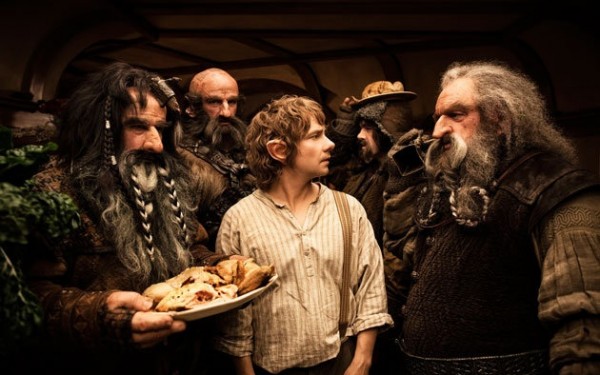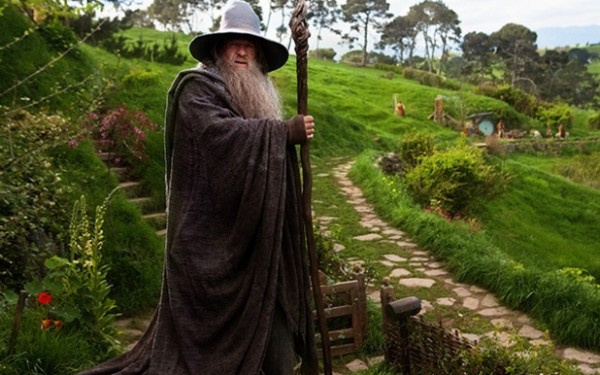Peter Jackson brings The Hobbit to a theater near you ■ by Rick Nagy
Like many other fans of JRR Tolkien, and Peter Jackson’s Lord of the Rings films, I breathed a sigh of relief upon hearing that Jackson had taken the helm of The Hobbit from Guillermo Del Toro. Don’t get me wrong – I like Del Toro’s Movies, but it was evident he just didn’t get the world of Tolkien. I feel confident that when I walk into the theater at midnight on December 14th to see An Unexpected Journey, the first installment of The Hobbit, Jackson’s long-awaited “prequel” to Lord of the Rings, it will have been worth the wait.

Bilbo Baggins Hosts An Unexpected Party In “The Hobbit”
■
It wasn’t just that Del Toro wanted to inject a post-modern artiness into the project; he simply didn’t understand what lay at the heart of Tolkien’s world: language.
In an interview with The New Yorker last year, Del Toro showed off some of the movie’s production drawings. What really caught my attention was his description of Thorin Oakenshield, the dwarf chieftain whom hobbit Bilbo Baggins follows in the essential quest at the heart of The Hobbit. Apparently, Thorin’s helmet should be shaped like a crown of thorns, because, “after all,” according to Del Toro, “his name is Thorin.”
This, of course, elicited from me a loud “NO, NO, NO” in my best Simpsons “comic book guy” voice. Never mind the hackneyed, unnecessary Jesus reference (There’s nothing particularly Christ-like about Thorin Oakenshield), but the name Thorin is not related to the English word for Thorn. Let me nerd-out a little here: Thorin comes from the Norse, and means “bold.” But more than that, the name is related to his lineage in Middle Earth, and shows the relation to his forbears Thror and Thrain. This is evident to even casual readers of The Hobbit. Names carry a lot of weight in Middle Earth, and nobody possessed of more than a passing familiarity with Tolkien would have made such a fundamental mistake. Del Toro had shown he was not worthy of the undertaking.
And while it’s true I still have a problem with Peter Jackson’s Thorin Oakenshield, it is a much less serious, and primarily aesthetic, problem: Jackson doesn’t casually brush aside Tolkien’s understanding of how language works. Jackson’s Thorin is a young, handsome swashbuckler – entirely different than the grey-bearded ancient of Tolkien’s book. I have, however, decided to withhold judgment because I trust Jackson’s understanding of Tolkien’s world.
Professor Tolkien was very particular about the language in his books. He was a professional philologist, an Oxford Don, a professor of Anglo Saxon, and one of the editors of The Oxford English Dictionary. Here we have a man who cost his publishers a considerable amount of money because his plural word “dwarves” was reproduced as “dwarfs” in one of the first editions of The Hobbit, and this would just not do.
Tolkien thought his works unfilmable, and many of his fans speculate that he would have been livid about all the changes Peter Jackson made to the story in his epic adaptation of “Lord of the Rings,” Tolkien’s most famous book, and one of the most widely read of the twentieth century. But I think Peter Jackson’s adaptation is one of the great films, and a fitting tribute to Tolkien. (I consider Jackson’s “trilogy”one long film in three installments, just as the three parts of LOTR really constitute one novel. For those LOTR fans with the stamina, Showplace West in Bloomington will host a one-day marathon on December 8th.) And while I have some misgivings about The Hobbit, which I’ll discuss below, my hopes are still high that Jackson has produced another masterpiece.
I like to imagine the young JRR Tolkien, standing on a battlefield in WWI, surveying the smoke, the trenches, the death. While doing so, he creates another world, based on his own, but imagined in a far distant, different past – a world called Middle Earth.
Gandalf, In “The Hobbit”
■
Those initial stories he created as a young man would not be published until after his death; his son Christopher would complete what the professor considered the great work of his life: “The Silmarillion,” the mythology of Middle Earth. “The Silmarillion” is one of the world’s great mythologies, complete with its own creation and hero stories that rival the Greek myths. It is mostly concerned with The Eldar, or as we would say, Elves. Tolkien the philologist had invented two languages, and needed to create the world in which these languages would be spoken, a world where those who spoke those languages would dwell. “The Silmarillion” is the bible of that world.
This love and deep knowledge of language is what sets Tolkien and his world apart from every other fantasy writer. Every word, every phrase, every bit of verse, is only the entrance to a new rabbit hole which leads to Middle Earth, and that makes it an utterly convincing alternate world. The farther down that linguistic rabbit-hole one goes, the more meaning Tolkien’s works have. Tolkien did not simply make up words that have a foreign, mythical sound about them (very noticeable in most fantasy works); his languages are steeped in our own history, and draw upon several sources for their depth and their beauty.
Professor Tolkien’s world, his Middle Earth, is so detail-laden, so exacting in its geography, geology, flora and fauna, that nothing seems false. He gave his whole life to creating this world, and as many have observed, his works sometimes read like history rather than fiction. Middle Earth may be based on our own world, or specifically Great Britain, but is different enough to transport readers out of our own. And it all started with language.
One of the languages so beloved by Tolkien was Welsh, and local author Mark T. Hooker’s collection of essays, Tolkien and Welsh, is a fine explication of just how Tolkien drew upon that language to help create such a convincing world. Again, it wasn’t enough to just make up words and names – those words and names had to have history.
I hope he’ll pardon my description of his life’s work, but his bibliography bears me out: Hooker is a Tolkienologist. Hooker shows how Tolkien uses linguistic devices like mutation, and picks out specific examples from throughout Tolkien’s books to describe this process.
Okay. Despite the blurb on the back cover that Hooker “writes primarily for the lay person,” meaning people who are not professional linguists, presumably, you still have to be pretty far down that Tolkien rabbit hole to appreciate the book. My point is, again, that understanding how Tolkien used language to create Middle Earth is important in understanding his works as more than just great stories. You simply don’t go around saying, “Well, ‘Thorin’ sounds like ‘thorn,’ so well give him a helmet that looks like thorns.”
It’s a long-standing dictum about many adapted films that “the book is better,” a sentiment I’ve never entirely understood. Certainly, there have been terrible movies adapted from books, but they are terrible not because of the changes necessary in filmic storytelling, but because they are just bad movies.
But think of all the great movies that tell an essentially different story than the book on which they are based. L.A. Confidential comes to mind. There was no way to include all the labyrinthine details from James Ellroy’s novel, but director Curtis Hanson kept the feel of the book’s intrigue and dark underbelly by telling a story that works on film.
Peter Jackson certainly has his detractors – “word-for-word” types who wouldn’t be happy with films that don’t show every detail from the book. But that was never an option. Not only would the films be commercial disasters – a real consideration given the budget – but frankly, boring. Film adaptation is an art unto itself; for anybody who thinks Jackson missed the mark, I highly recommend watching the “Appendices” sections of the LOTR extended-edition DVDs, especially as they pertain to why Jackson and his fellow screenwriters made the changes they did to the story.
Phillipa Boyens, the primary screenwriter of Jackson’s LOTR, and a very obvious Tolkien geek, is quite clear in the “appendices” about why certain additions, deletions and changes were made, meeting the criticisms of the “word-for-word” advocates head on. Her explanation of the changes in Faramir from book to film, one of the many sticking points to Tolkien purists, is particularly convincing. More than anything, the appendices to the DVDs show just how much Jackson understands Tolkien, and called the right shots to make what may be the most involved film project in history.
One minor change that makes me so confident in Jackson as an interpreter of Tolkien takes place in the “Council of Elrond” scene in Fellowship of the Rings. In the movie, when Boromir asks what “a ranger of the north” would know of (the matters discussed at the council), Legolas tells him the ranger is, in fact, Aragorn, son of Arathorn. With only that much information, the Boromir of the film knows that Aragorn is Isildur’s heir. I would argue that this shows Jackson’s understanding of the importance of names and language in Tolkien, and so, stands in stark contrast to Del Toro’s ignorance.
My initial concerns about The Hobbit have nothing to do with language, but with more technical aspects, particularly Jackson’s decision to film at 48 frames per second and in 3D. Jackson may very well be right when he says that 48 fps will be the future standard (it has been 24 fps for most of film history), but I disagree that adopting the technology first will “future proof” The Hobbit. Early test audiences said the film had a cold sterile look, and the first trailers I saw seemed to bear that impression out. The first adoptions of any new technology inevitably become dated and quaint, especially in comparison to later uses of the same technology. And, since most theaters won’t be showing the film in the 48 fps format, it seems like a waste of the technology.
As far as 3D: I don’t want to sound like one of those people who thought air travel was a fad, but….
A director has to make choices for 3D that he otherwise might not have made. Given the scope of the project, I trust to hope that Jackson will not fill The Hobbit with objects flying at the audience, but will create a world that audience feels a part of, creating depth, not simply surprise.
But I have to say, the most recent trailer for the film is amazing. While the images are certainly crisp, like Blu-ray, there is a warmth and a light very similar to LOTR. Jackson’s Weta Digital is the most advanced special effects house in the world, and he has pulled out all the stops. Advances in CG animation technology have improved exponentially since the already impressive Return of the King was released in 2004; the Gollum in the trailer, for example, is lifelike in ways the LOTR Gollum, which at the time seemed impossibly real, was not.
Jackson recently announced that, like Lord of the Rings, The Hobbit will have three installments. Given that The Hobbit as a novel is one third the length of LOTR, perhaps Jackson has decided to make a very close adaptation of the book. The trailers suggest scenes which are either not in the book, or to which the book only alludes. Either way, the same legion of fans that made LOTR a blockbuster will no doubt return, even if they return with doubts. For my part, Peter Jackson is exactly the right person to bring Tolkien’s first book to life on film, and on December fourteenth at midnight, I’ll know for sure.
■
The Ryder, December 2012

